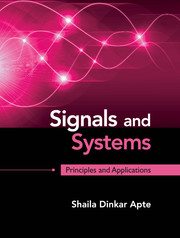Book contents
- Frontmatter
- Dedication
- Contents
- Preface
- 1 Introduction to Signals
- 2 Signals and Operations on Signals
- 3 CT and DT Systems
- 4 Time Domain Response of CT and DT LTI Systems
- 5 Fourier Series Representation of Periodic Signals
- 6 Fourier Transform Representation of Aperiodic Signals
- 7 Laplace Transform
- 8 Z Transform
- 9 Random Signals and Processes
- Index
2 - Signals and Operations on Signals
Published online by Cambridge University Press: 05 May 2016
- Frontmatter
- Dedication
- Contents
- Preface
- 1 Introduction to Signals
- 2 Signals and Operations on Signals
- 3 CT and DT Systems
- 4 Time Domain Response of CT and DT LTI Systems
- 5 Fourier Series Representation of Periodic Signals
- 6 Fourier Transform Representation of Aperiodic Signals
- 7 Laplace Transform
- 8 Z Transform
- 9 Random Signals and Processes
- Index
Summary
This chapter aims to introduce basic concepts related to CT and DT signals and operations on the signals such as translation, scaling, addition, multiplication, etc.
Natural signals like speech, seismic signal, Electro Cardio Gram (ECG) and Electro Encephalogram (EEG) signals are processed using sophisticated digital systems. All these information-carrying signals are functions of the independent variables, namely, time and space. We first deal with basic definition and classification of signals.
Signals
We have gone through the basics of signals in chapter 1. We will go through it in detail in this chapter. Let us first define a signal.
Definition of a signal A signal is defined as a single valued function of an independent variable, namely, time that conveys some information. At every instant of time there is a unique value of the function. The unique value may be real or complex.
A signal X is represented as X = F(t), where F is some function and t represents time, the independent variable. Here, time is a continuous variable and X also takes on continuous values. X is then termed as continuous time, continuous amplitude (CTCA) signal that is the analog signal. When a signal is written as some mathematical equation, it is deterministic in the sense that the signal value at any time t can be determined using the mathematical equation. A signal is called scalar-valued if its value is unique for every instant of time. Most of the naturally occurring signals are scalar-valued, real, analog and random in nature. Speech signal is an example of such naturally occurring random signals. Speech signal is generated when a person utters a word. Researchers are still trying to generate a model for speech signal and exact mathematical equation cannot be written for a speech signal. It has a random signal component of some strength. It is called as random signal. If a signal has multiple values at any instant of time, it is called vector-valued. For example, color images, where at every pixel there is a three-dimensional vector representing RGB color components. In this chapter we will refer to scalar-valued and deterministic signals only. Hence, the signals will always be represented in the form of an equation.
- Type
- Chapter
- Information
- Signals and SystemsPrinciples and Applications, pp. 24 - 180Publisher: Cambridge University PressPrint publication year: 2016



